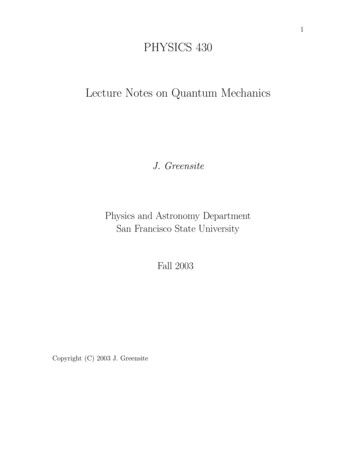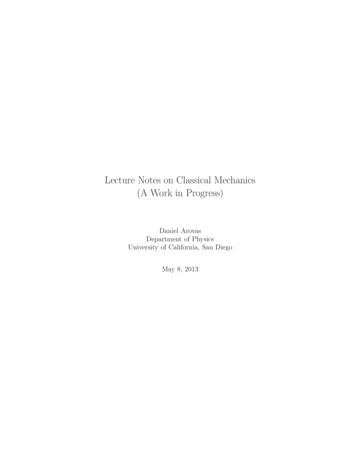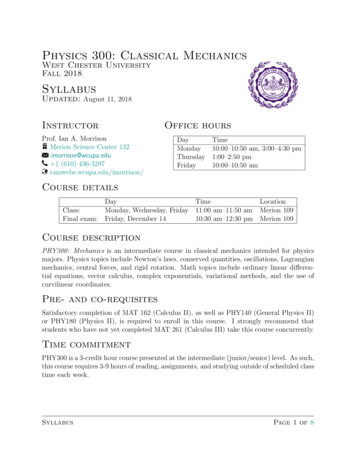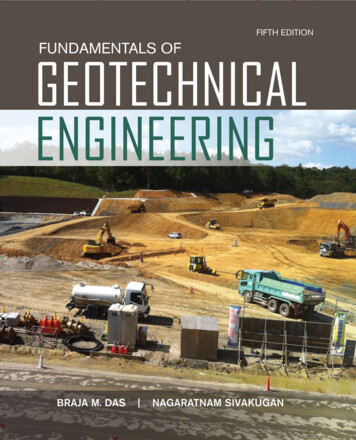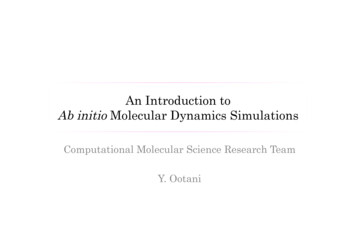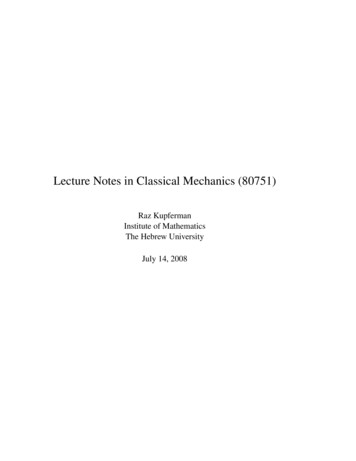
Transcription
Lecture Notes in Classical Mechanics (80751)Raz KupfermanInstitute of MathematicsThe Hebrew UniversityJuly 14, 2008
2
Contents123Preliminaries11.1Vector calculus . . . . . . . . . . . . . . . . . . . . . . . . . . .11.2Dimensional analysis . . . . . . . . . . . . . . . . . . . . . . . .5Newtonian Mechanics152.1Kinematics . . . . . . . . . . . . . . . . . . . . . . . . . . . . . 152.2Dynamics: Newton’s laws . . . . . . . . . . . . . . . . . . . . . 182.3Work and mechanical energy . . . . . . . . . . . . . . . . . . . . 232.4Angular momentum and torque . . . . . . . . . . . . . . . . . . . 262.5Systems of point particles . . . . . . . . . . . . . . . . . . . . . . 272.6What is missing? . . . . . . . . . . . . . . . . . . . . . . . . . . 332.7d’Alembert’s principle of virtual work . . . . . . . . . . . . . . . 372.8Examples . . . . . . . . . . . . . . . . . . . . . . . . . . . . . . 41Variational Calculus453.1The brachistochrone . . . . . . . . . . . . . . . . . . . . . . . . . 453.2Functionals over normed spaces . . . . . . . . . . . . . . . . . . 473.3Functional derivatives . . . . . . . . . . . . . . . . . . . . . . . . 483.4Necessary conditions for a local extremum . . . . . . . . . . . . . 503.5The Euler-Lagrange equations . . . . . . . . . . . . . . . . . . . 52
ii45678CONTENTSLagrangian mechanics554.1Hamilton’s principle . . . . . . . . . . . . . . . . . . . . . . . . 554.2Conservation theorems . . . . . . . . . . . . . . . . . . . . . . . 56The two-body central force problem595.1Reduction to a one-particle system . . . . . . . . . . . . . . . . . 595.2Analysis of the reduced one-particle problem . . . . . . . . . . . 615.3Classification of orbits . . . . . . . . . . . . . . . . . . . . . . . 645.4Orbit equations . . . . . . . . . . . . . . . . . . . . . . . . . . . 665.5Gravitational systems . . . . . . . . . . . . . . . . . . . . . . . . 67Small oscillations716.1Equilibria and deviations . . . . . . . . . . . . . . . . . . . . . . 716.2Normal mode equations . . . . . . . . . . . . . . . . . . . . . . . 736.3Oscillations of a tri-atomic molecule . . . . . . . . . . . . . . . . 74Hamiltonian mechanics777.1The Legendre transformation . . . . . . . . . . . . . . . . . . . . 777.2Hamilton’s equations . . . . . . . . . . . . . . . . . . . . . . . . 797.3Symmetries and conservation laws . . . . . . . . . . . . . . . . . 867.4Derivation through a variational principle . . . . . . . . . . . . . 877.5Final comments . . . . . . . . . . . . . . . . . . . . . . . . . . . 88Canonical transformations898.1Motivation . . . . . . . . . . . . . . . . . . . . . . . . . . . . . . 898.2Canonical transformations . . . . . . . . . . . . . . . . . . . . . 908.3Choices of generating functions . . . . . . . . . . . . . . . . . . 918.4The symplectic approach . . . . . . . . . . . . . . . . . . . . . . 948.5Poisson brackets . . . . . . . . . . . . . . . . . . . . . . . . . . . 968.6Poisson bracket formulation of mechanics . . . . . . . . . . . . . 998.7Differentiable transformations . . . . . . . . . . . . . . . . . . . 99
CONTENTS8.89iiiLiouville’s theorem . . . . . . . . . . . . . . . . . . . . . . . . . 101The Hamilton-Jacobi theory1039.1The Hamilton-Jacobi equation . . . . . . . . . . . . . . . . . . . 1039.2An example . . . . . . . . . . . . . . . . . . . . . . . . . . . . . 10510 Quantum mechanics10710.1 Matter and waves . . . . . . . . . . . . . . . . . . . . . . . . . . 10710.2 The postulates of quantum mechanics . . . . . . . . . . . . . . . 11010.3 A particle in a potential well . . . . . . . . . . . . . . . . . . . . 11210.4 The harmonic oscillator . . . . . . . . . . . . . . . . . . . . . . . 115
ivCONTENTS
Chapter 1Preliminaries1.1Vector calculusAccording to classical physics, “reality” takes place in a product space R3 R,where R3 represents space and R represents time. The notions of space and timeare axiomatic in classical physics, meaning that they do not deserve a definition.(In relativistic physics, the notions of space and time are intermingled, and onerather speaks about a four dimensional space-time.)Because the physical space is a three-dimensional vector space, we will have todeal extensively with vectors in R3 . We will denote vectors by boldface characters,e.g., a, b, c. After choosing an an orthonormal basis, the entries, or componentsof a vector in R3 are commonly denoted bya (a1 , a2 , a3 ).At times we will use different notations, such as r (x, y, z).Let a and b be two vectors in R3 . Their scalar product, or dot product is a realnumber defined bya · b a1 b1 a2 b2 a3 b3 3!ai bi .i 1Physicists often adopt a notational convention, the Einstein summation convention, whereby indexes that appear twice in an expression are summed over, without need of the summation sign. That is,a · b ai bi .
2Chapter 1While confusing at first, this notation ends up being very useful. Of course, whatphysicists call a scalar product is nothing but the standard inner product in R3 .The length, or magnitude of a vector a, is its Euclidean norm, a (a · a)1/2 ai ai .The scalar product of two vectors, can be attributed a geometric meaning thatinvolves the angle, θ, between the two vectors,a · b a b cos θ.Two (non-zero) vectors are said to be orthogonal (denoted a b) if their dotproduct vanishes, i.e., if θ π/2.We will often denote the standard basis in R3 bye1 (1, 0, 0),e2 (0, 1, 0),e3 (0, 0, 1).andThus, a vector can be also written asa a1 e1 a2 e2 a3 e3 ai ei .Other times, we will rather denote e1 x̂, e2 ŷ, and e3 ẑ.Proposition 1.1 The dot product satisfies the following properties:!"# It is commutative, a · b b · a.It is bilinear, (αa) · b α(a · b).It is distributive, a · (b c) a · b a · c.The Cauchy-Schwarz inequality, a · b a b .We define another product between pairs of vectors, the cross product, or thevector product. Unlike the dot product, the cross product results in a vector. Itcan be defined in several ways, for example,"""""e1 e2 e3 """a b ""a1 a2 a3 "" (a2 b3 a3 b2 )e1 (a3 b1 a1 b3 )e2 (a1 b2 a2 b1 )e3 ."""b1 b2 b3 "The other way is to define the cross products of all pairs of basis vectors, e.g.,e1 e1 0,e1 e2 e3 ,etc.,
Preliminaries3and impose bilinearity and distributivity. A third definition introduces the LeviCivita tensor, 1 if (i, j, k) is (1, 2, 3), (2, 3, 1), or (3, 1, 2) i jk 1 if (i, j, k) is (1, 3, 2), (2, 1, 3), or (3, 2, 1) . 0otherwise.Then, the cross product takes the simple form,a b i jk ei a j bk .A very useful property of the Levi-Civita tensor (easily checked by explicit substitution) is i jk imn δ jm δkn δ jn δkm .(1.1)The cross product also has a geometric interpretation. First, we claim that forevery a, b,a · (a b) b · (a b) 0,that is, the cross product of two vectors is perpendicular to both. While this can beverified by a (relatively) tedious substitution, the clean way of deriving this resultis using our index notation, e.g.,a · (a b) (ai )( ikl ak bl ) ikl ai ak bl .Now, ikl changes sign when a pair of indexes is switched, hence,a · (a b) kil ai ak bl ikl ai ak bl ,where we have just renamed the summation indexes i k and k i. Thus, thistriple product equals minus itself, hence it is zero.What about its magnitude? Note that a b 2 (a b) · (a b) i jk a j bk imn am bn .Using the product formula (1.1) for the Levi-Civita tensor, a b 2 (δ jm δkn δ jn δkm )a j bk am bn a j bk a j bk a j bk ak b j a 2 b 2 (a · b)2 a 2 b 2 (1 cos2 θ),
4Chapter 1Figure 1.1: Visualization of the cross product.i.e., a b a b sin θ.Thus, the cross product of two vectors is a vector perpendicular to both, whosemagnitude equals to the area of the parallelepiped formed by the two vectors. Itsdirection is determined by the right hand rule (see Figure 1.1).Proposition 1.2 The cross product satisfies the following algebraic properties:! Anti-symmetry: a b b a." Distributivity: a (b c) a b a c.# Bilinearity, (αa) b α(a b). It is not associative.% Jacobi’s identity: a (b c) c (a b) b (c a) 0.& The vector triple product, or “BAC minus CAB” formula: a (b c) b(a · c) c(a · b).' The scalar triple product formula, a · (b c) b · (c a) c · (a b).( Exercise 1.1 Prove it.
Preliminaries1.25Dimensional analysisUnits of measurement All physical quantities are expressed in terms of numbers, obtained through measurements, during which comparison is made with astandard, or, a unit of measurement. For example, the length of a ruler is measured by comparison to a standard, say the meter; the mass of a rock is measuredby comparison with a unit mass, say, the gram; the duration of the day is measured by comparison with a unit time, say the time it takes a standard hour-glassto empty; the (mean) velocity of a car is measured by measuring the distance itwent, say in inches, the time it took, say in milliseconds, and dividing those twonumbers.Fundamental and derived units The units of measurements are divided intotwo categories: fundamental units and derived units. Suppose we want to studya class of phenomena, for example, the motion of bodies. We may list all thequantities which will ever be measured, and for certain of them choose units ofmeasurement, which we will call fundamental units; the choice is arbitrary. Forexample, we may choose fundamental units of mass, length, and time (but alsoforce, length and time). Derived units of measurements are based upon the fundamental units via some method of measurement (perhaps only conceptual). Forexample, the measurement of velocity, whose (derived) units uses the (fundamental) units of length and time.Systems of units A set of fundamental units that is sufficient for measuring theproperties of a class of phenomena is called a system of units, for example,cgs centimeter, gram, secondin mechanics.Classes of systems of units Two systems of units which differ only in the magnitude of their standards, but not in their physical natures, are said to belong to thesame class. For example, all systems of units which are of the formunit of length cm/Lunit of mass gram/Munit of time second/T,
6Chapter 1with L, M, T 0, belong to the same class (the LMT class). Another class, theLFT class consists of systems of units of the formunit of length cm/Lunit of force kg-f/Funit of time second/T.(For the time being, ignore the fact we have no clue what “force” means. All youneed to understand, is that it is a physical quantity that can be measured with theappropriate apparatus.)Note, however, that while both classes, the LMT and LFT classes, form a systemof units for a class of physical phenomena which we call mechanics, they are nota sufficient set of units if we want, in addition, to measure, say, temperature, or anelectric charge.Dimensions Suppose we choose a class of system of units, for example, theLMT class in mechanics, and suppose we change our system of units within thesame class, by decreasing the length unit by a factor L, the mass unit by a factorM, and the time unit by a factor T (e.g., we use centimeters rather than meters,ounces rather than grams, and weeks rather than seconds). How will this affectthe magnitude of the outcome of measurements?Length measurements will be magnified by a factor of L; mass measurements willbe magnified by a factor of M; time measurements will be magnified by a factor ofT ; velocity measurements will be magnified by a factor of LT 1 , and so on. Everyphysical quantity will be magnified by a factor which depends on L, M, T . Thatis, every physical quantity has an associated function of L, M, T , which we call itsdimension. The dimension of mass density (mass per unit volume), for example,is ML 3 . A quantity which remains invariant under a change of units is calleddimensionless, and its dimension is by definition one. Note that the dimension ofa physical quantity depends on the class of the system of units!( Exercise 1.2 Consider the MVT class where the fundamental units are that ofmass, velocity and time. What kind of experiment measures length? What is thedimension of length? What is the dimension of mass density?Physics is usually not thought in terms of an axiomatic theory. One rather speaksabout fundamental principles. The most fundamental principle in all branchesof physics is probably the following:
Preliminaries7The laws of physics are invariant under the choice of systemsof units.What are laws of physics? They are relations between measurable quantities. Forexample, a physical law states that the force of attraction between two physicalbodies (which can be measured) is proportional to the masses of each of them(which can be measured), and inversely proportional to the square of their separation (which can be measured independently).The first observation to be made is that if a physical law is of the formexpression 1 expression 2,then both expression must have the same dimension, otherwise the identity couldnot hold independently on the system of units.The dimension is always a power-law monomial So far, all dimension functions were always power-law monomials. Is it a coincidence? Suppose we workwithin the LMT class, and we are interested in some quantity a. By assumption(that the LMT class is complete), the dimension of a only depends on L, M, T :[a] f (L, M, T ).What does it mean? That if we change units by dividing the units of length, massand time by L1 , M1 , T 1 , the measured value a1 will increase by f (L1 , M1 , T 1 ).Similarly, if we change units by dividing the units of length, mass and time by L2 ,M2 , T 2 , the measured value a2 will increase by f (L2 , M2 , T 2 ). That is,f (L2 , M2 , T 2 )a2 .a1f (L1 , M1 , T 1 )The underlying assumption is that all systems of units within a given class areequivalent. Thus, we may think of the system 1 as the original system, and system2 as obtained by decreasing the fundamental units by L2 /L1 , M2 /M1 , and T 2 /T 1 .Then,a2 a1 f (L2 /L1 , M2 /M1 , T 2 /T 1 ),from which immediately follows the functional equation'(f (L2 , M2 , T 2 )L2 M2 T 2 f,,.f (L1 , M1 , T 1 )L1 M1 T 1
8Chapter 1What can be learned from such a functional relation?Assuming that the dimension function is smooth, we differentiate both sides withrespect to L2 and set L2 L1 L, M2 M1 M, and T 2 T 1 T ,1 f1 fα(L, M, T ) (1, 1, 1) ,f (L, M, T ) LL LLfrom which we conclude thatf (L, M, T ) Lα g(M, T ).Substituting into the functional equation we get'(g(M2 , T 2 )M2 T 2, g,g(M1 , T 1 )M1 T 1and by the same procedure get thatg(M, T ) M β h(T ).Repeating this for a third time we get h(T ) cT γ , i.e.,f (L, M, T ) c Lα M β T γ .Since f (1, 1, 1) 1, we conclude that c 1.Quantities with independent dimensions The physical quantities a1 , . . . , akare said to have independent dimensions if none of these quantities have a dimension which can be presented as a power monomial of the dimensions of theremaining quantities. It is perhaps easier to give a logarithmic formulation. In theLMT system, for example, every set of physical quantities (ai ), i 1, . . . , k, has adimension functions of the form,log [a1 ] α1 log L β1 log M γ1 log T. .log [ak ] αk log L βk log M γk log TThat is, the logarithms of dimensions form a vector space with basis vectors log L,log M, log T . Independence of dimension is linear independence over this space.
Preliminaries9Obviously, in this case there can be at most three physical quantities of independent dimension.Suppose now physical quantities a1 , . . . , ak and b1 , . . . , bm , such that the first khave independent dimensions, and all the m additional quantities have dimensionsthat depend on the dimensions of the first k quantities. The fact that the ai haveindependent dimensions implies that if we work, say, with an L1 L2 . . . Lr system,then necessarily, r k and if log [a1 ] γ11 · · · . . . . γk1 · · ·log [ak ] γ1r log L1 . . ,. . γkr log Lrthen the matrix of coefficients has full rank (i.e., k). This has an important implication: it is possible to change units of measurement such that, as a result, a singlea j changes its value, while all the other remain fixed.Now we come to the b j . Since their dimensions depend on the dimensions of thea j , then there exist constants αi j , such thatlog [b1 ] α11 log [a1 ] · · · α1k log [ak ]. .log [bm ] αm1 log [a1 ] · · · αmk log [ak ] .Consider now the following new quantities,b1. . . aαk 1k. .bmΠm αm1.a1 . . . aαk mkΠ1 aα1 11It is easy to see that these quantities are dimensionless; their value does notchange, no matter how we change our units of measurement.Physical laws A physical law always consists of a relationship between physicalquantities,c f (a1 , . . . , ak , b1 , . . . , bm ).(1.2)
10Chapter 1Here c is the quantity being determined and a1 , . . . , ak , b1 , . . . , bm are all the quantities it depends upon (as above, the a j have independent dimensions). It is important to stress that a physical law is an equation that relates between measurablequantities. There exists a function f , such that if one measures the quantities a j ,b j , and c, the numbers thus obtained satisfy the prescribed equation.We first claim that the dimension of c must depend on the dimension of the a j .Why is it so? Otherwise, we could perform a change of units of measurement,such that the value of c changes, while the values of all the a j (and consequentlyall the b j ) remain unchanged. This would contradict the assumption that f is onlya function of those physical quantities. Thus, there exist numbers β1 , . . . , βk , suchthat[c] [a1 ]β1 . . . [ak ]βk ,and the physical quantityΠ caβ11 . . . aβk kis dimensionless.The Π theorem Using our definitions of dimensionless quantities, we can rewrite(1.2) as follows:Π 1aβ11 . . . aβk k/0f a1 , . . . , ak , aα1 11 . . . aαk 1k Π1 , . . . , aα1 m1 . . . aαk mk Πm ,and this can be brought into an alternative form,Π F(a1 , . . . , ak , Π1 , . . . , Πm ).That is, we rewrote (1.2) as a relation between k physical quantities of independent dimension and m dimensionless quantities, on one side, and a dimensionlessquantity, on the other side.Now remember we can perform a change of units such that only a1 changes itsvalue. Thus, F cannot depend on a1 . By repeating this argument k times we endup with the conclusion thatΠ F(Π1 , . . . , Πm ).This is known as the “Π-theorem”. A physical relationship between some dimensional parameter and several dimensional governing parameters can be rewritten
Preliminaries11as a relation between some dimensionless parameter and several dimensionlessproducts of the governing parameters.What is the immediate gain? A law that seemed to depend on k m parametersreduces into a law that only depends on m parameters. This might be a hugereduction.Example: In Euclidean geometry it is known that the area S of a right triangledepends only on the length of its hypotenuse, c, and the magnitude φ of, say, thesmaller of its acute angles. Thus,S f (c, φ).For this problem we can do well with for only fundamental units those of length(an L system). In this case, c has dimension L, φ is dimensionless and S hasdimension L2 . By the Π-theorem, the dimensionless quantity Π S /c2 can onlydepend on the dimensionless parameter Π1 φ,Π F(Π1 )S c2 F(φ). Without caring what the function F actually is, we have at once,S 1 a2 F(φ),S 2 b2 F(φ),S 1 S 2 c2 F(φ),from which follows Pythagoras’ theorem.S2cbS1!!a!
12Chapter 1Example: A mass m is thrown vertically with velocity v. What is the maximalheight h it will attain? We start withh f (m, v, g).Since [h] L, [m] M, [v] L/T and [g] L/T 2 , we conclude from theΠ-theorem thathΠ 1 const.v2 /g!( Exercise 1.3 A pendulum is a massive particle suspended on a string (whichwe assume to have negligible mass). If one perturbs the pendulum (for exampleby placing it at the equilibrium point, but assigning it an initial velocity), then thependulum performs a periodic motion. Suppose we want to find a law to predictthe period, τ, of the motion. We start by making a list of all quantities that τ maydepend upon: (1) the mass m of of the particle, (2) the initial velocity v, (3) earth’sacceleration g, and (4) the length of the string, . In the LMT system we have[τ] T[m] M[v] LT! What can you say about the function2 3Lg 2T[ ] L.τ f (m, v, g, )based on dimensional analysis?" Suppose now an experimentalist tells you that the period does not dependon the initial velocity. How will your answer change?Example: In an atomic explosion, a large amount of energy E is released withina small region, and a strong spherical shock wave develops at the point of detonation. In the early stages, the pressure behind the shock wave is huge compared tothe atmospheric pressure, which is completely negligible. If r denotes the radiusof the wave and t is time, the radius is only expected to depend onr f (t, E, ρ),where ρ is the density of the air at equilibrium (no shock wave without air density,and other characteristics of air, such as sound wave speed are irrelevant for shockwaves).
Preliminaries13The dimensions of the governing parameters in the LMT class are[t] T[E] ML2 T 22 3ρ ML 3 .It is easy to see that those are all independent, i.e., k 3 and m 0. Thedimension of r is L, so thatρ1/5 rΠ 1/5 2/5E tis dimensionless, and depends on nothing, i.e., must be a constant. This meansthatr C ρ 1/5 E 1/5 t2/5 ,or112log ρ log E log t.555Thus, if we plot log r versus log t, the slope should be 2/5, and the graph shouldintersect zero at the valuelog r log C log C 11log ρ log E.55Since ρ is known, knowing the constant C would reveal the energy of the blast.In the 1940’s the Americans performed nuclear tests, which were photographedby J. Mack. Those photographs were not classified. G.I. Taylor analyzed thosepictures. He knew that the constant C was about O(1) (one can find it from a smallexplosion), and based on the above analysis published the value of the energy(about 1021 ergs) which caused a huge embarrassment.!
14Chapter 1
Chapter 2Newtonian MechanicsIn this chapter we will review the basics of Newton’s “old” classical mechanics—old in the sense that it is less general and formal than the more recent formulationsof Lagrange and Hamilton—classical, to distinguish from quantum mechanics.2.1KinematicsMechanics primarily deals with the motion of so-called point particles. A pointparticle is a model of a physical object whose state is fully specified by its location, the latter being a point in R3 . It is important to distinguish between modelsand reality. The point particle is an idealization, which can only be justified empirically. At times, the solar system can be described as comprised of point particles,even though the sun and the planets are complex objects. In other instances, evena round tennis ball cannot be modeled as a point particle (e.g., if rotation is important).Physics make predictions about how physical entities evolve in time. Given apoint particle, its evolution is completely determined by its position r (x, y, z),as function of time t, or its trajectory. Mathematically, the trajectory r(t) is apath in R3 . For the time being, we will assume that the trajectory is at least twicedifferentiable with respect to time; the justification for this assumption will begiven in the next section.Note that the definition of r assumes the choice of an origin, with a specific orientation of the principal axes. In order to be able to measure r we also need a unit
16Chapter 2of length. Centimeters and meters are the most common choices (for those whohave never heard of inches and feet.). Time also requires an origin and a unit ofmeasurement, seconds being the most standard choice.The rate-of-change of the position r(t), is the vectorv(t) dr(t),dtwhich is called the velocity vector of the point particle. Note that this is a vectoridentity, namely,v (v1 , v2 , v3 ), withv1 dx,dtv2 dy,dtandv3 dz.dtThe measurement of velocity is somewhat “conceptual”. We imagine two measurements of position at time t and time t t, and an approximation to velocityin terms of the change in r divided by t. The actual velocity is the limit where tis infinitely small. Despite the fact that the exact velocity can never be measured,this conceptual measurement suffices to assign velocity dimensions of L/T , whereL is the dimension of length and T the dimension of time. If we measure lengthin units of meters and time in units of seconds, then the ratio of r/ t is assigneda unit of meters/seconds. This unit has to be understood in the following way:the velocity was determined by a ratio of displacement and time interval, in anexperiments in which length was measured in meters and time in seconds.Note that if we know the velocity as function of time, v(t), then the position canbe retrieved by integration, but only up to a constant translation,r(t) r(t0 ) 4t0tv(s) ds.If the velocity is constant, v(t) v, then the displacement is a linear function oftime,r(t) r(t0 ) v(t t0 ).The time derivative of the velocity, which is the second derivative of the trajectory,is called the acceleration of the point particle, and is denoted bya(t) d2 rdv(t) 2 (t).dtdt
Newtonian Mechanics17Acceleration has dimensions of L/T 2 , and is usually measured in units of m/sec2(again, we don’t really mean that a meter is divided by the square of a second).Given the acceleration, a(t), the velocity is given by4 tv(t) v(t0 ) a(s) ds,t0and the position is given byr(t) r(t0 ) v(t0 )(t t0 ) 4 t4t0st0a(τ) dτ ds.When the acceleration is constant a(t) a, thenv(t) v(t0 ) a(t t0 ),from which we obtain the trajectory,1r(t) r(t0 ) v(t0 )(t t0 ) a(t t0 )2 ,2which requires the knowledge of the initial position and velocity of the point particle.Example: It is an empirical fact that bodies experiencing only the forces of gravityhave a constant acceleration,a (0, 0, 9.81)msec2regardless of their mass. Here it is assumed that the z-axis points upward, whereasthe x, y plane is tangent to the surface of earth. Suppose we are in a flying balloon,and we throw a massive body from the point (0, 0, 100) m with initial velocity(3, 0, 10) m/sec. When and where will the body hit the ground?By the above formula, setting t0 0,1r(t) (0, 0, 100) (3, 0, 10)t (0, 0, 9.81)t2 .2Componentwise, we havex(t) 3t,y(t) 0,andz(t) 100 10t 9.81 2t.2
18Chapter 2“When” is answered by solving the quadratic equation z(t) 0 (the result ismeasured in seconds). “Where” is answered by r(t) at the time of impact (theresult is measured in meters). Note also that the curve that the trajectory makes isa parabola,x 9.81 5 x 62z 100 10 .32 3!Circular motion Consider a circular trajectory at constant speed,r(t) (R cos ωt, R sin ωt, 0),R, ω 0.The velocity is given byv(t) ( Rω sin ωt, Rω cos ωt, 0),i.e., v(t) Rω, whereas the acceleration isa(t) ( Rω2 cos ωt, Rω2 sin ωt, 0) ω2 r(t),i.e., a(t) R2 ω. We took a very particular circular motion, in which the speed v is constant. The acceleration vector is directed toward the center of the circle, andin particular is perpendicular to the velocity vector.This is more general: for any motion where v(t) is constant,0 d v 2dv 2v · ,dtdti.e., v a.2.2Dynamics: Newton’s lawsSo far, we have only seen definitions, not physical laws. Physical laws are notinferred from a set of axioms, but are rather based on empirical observations.Their value is in the ability to capture a whole set of physical phenomena in arelatively small set of laws.Recall that a physical law is an equation that relates between physical quantities,each of which can be measured independently. A physical body, for example, has
Newtonian Mechanics19Figure 2.1: Sir Isaac Newton (1643–1727).a physical quantity associated with—a mass—or the “amount of matter”. Massis commonly measured in units of grams or kilograms (unless you buy it by theounce), and is denoted by m. The dimension of mass is independent of that oflength and time, and we denote it by M.The product of a particle’s mass and velocity, which was once called “the amountof motion” is called the momentum of the particle, and is denoted byp mv.Momentum is a vector that has dimensions of ML/T .Newton, in his work Philosophiae Naturalis Principia Mathematica (1687), formulated what is now known as Newton’s first and second laws of motion: thereexist frames of references in which particles have fixed momenta, unless thereis force exerted on them. When observed from such a reference frame, the rateof change of a particle’s momentum is proportional to the (vector) sum of all theforces acting on it. If the total force is denoted by f, then the first and second lawsstate thatdp.f dtChoosing the constant of proportionality amounts to choosing units of measurements. The unit of force Newton is defined as the amount of force needed tochange the momentum of a particle at a rate of one kg m/sec per second, in whichcase we have an equality. Clearly, force has dimensions of ML/T 2 . If the mass of
20Chapter 2the particle does not change in time, then this law reduces to the celebratedf ma.Note that force, as the derivative of a vector quantity is itself a vector.But what is force? Even Newton realized that he could only give a circular definition. Force is the thing that causes momentum to change, and momentum changesas a result of acting forces. (On the other hand, we certainly have from daily lifean intuitive notion of what force is.) Equipped with Newton’s second law, themodelling of a mechanical system consists of specifyi
According to classical physics, "reality" takes place in a product space R3 R, where R3 represents space and R represents time. The notions of space and time are axiomatic in classical physics, meaning that they do not deserve a definition. (In relativistic physics, the notions of space and time are intermingled, and one



